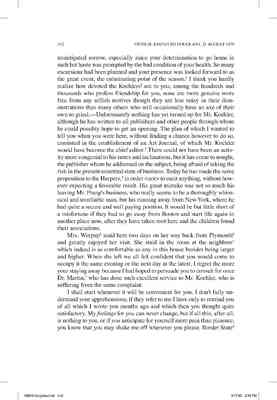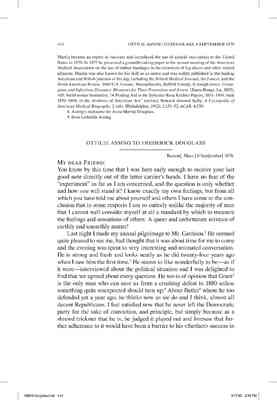Pages
page_0001
OTTILIE ASSING TO FREDERICK DOUGLASS
Boston[, Mass.] 21 Aug[ust] 1878.
MY DEAR FRIEND:
Your letter, which came this morning, produced a very keen feeling of disappointment and regret among all of us, for your telegram not having reached us, I imagined that you had been detained and would yet arrived some day this week. That hope has now vanished to be superseded by
page_0002
unmitigated sorrow, especially since your determination to go home in such hot haste was prompted by the bad condition of your health. So many excursions had been planned and your presence was looked forward to as the great event, the culminating point of the season.1Assing and Douglass did not reunite until September 1878, after a two-year separation. Diedrich, Love across Color Lines, 338. I think you hardly realize how devoted the Koehlers2Sylvester Rosa and Amalie Koëhler. are to you; among the hundreds and thousands who profess friendship for you, none are more genuine more free from any selfish motives though they are less noisy in their demonstrations than many others who will occasionally have an axe of their own to grind.—Unfortunately nothing has yet turned up for Mr. Koehler, although he has written to all publishers and other people through whom he could possibly hope to get an opening. The plan of which I wanted to tell you when you were here, without finding a chance however to do so, consisted in the establishment of an Art Journal, of which Mr. Koehler would have become the chief editor.3Sylvester Rosa Koëhler worked as the technical manager at Louis Prang from 1868 to 1879, when he left that company to become the editor of the American Art Review, a publication he started with Charles C. Perkins and William C. Prime. He remained as editor from 1879 until 1881, when the periodical ceased publication. Loring, “Koëhler,” 556–58. There could not have been an activity more congenial to his tastes and inclinations, but it has come to nought, the publisher whom he addressed on the subject, being afraid of taking the risk in the present unsettled state of business. Today he has made the same proposition to the Harpers,4James and John Harper established the firm Harper & Brothers in New York City in 1817. In 1833 their other brothers, Fletcher and Wesley, joined the business. Initially a book publishing business, the firm paved the way for the industrialization of publishing and the widespread distribution of printed matter in America. The company reached its highest point in the decades surrounding the Civil War, when it also began publishing a series of popular periodicals: Harper’s New Monthly Magazine in 1850, Harper’s Weekly: A Journal of Civilization in 1857, and Harper’s Bazaar in 1867. These publications brought politics, lifestyle, and literature into the average home while providing indispensable coverage of current events. The Weekly, a pioneer illustrated magazine, regularly published the political cartoons of Thomas Nast. Frederick Douglass was on the cover of the Harper’s Weekly issue of 14 November 1883. Eugene Exman, The House of Harper: One Hundred and Fifty Years of Publishing (New York, 1967); Hudson, Journalism in the United States, 587, 707–08. in order <not> to omit anything, without however expecting a favorable result. His great mistake was not so much his leaving Mr. Prang’s business, who really seems to be a thoroughly whimsical and unreliable man, but his running away from New-York, where he had quite a secure and well paying position. It would be but little short of a misfortune if they had to go away from Boston and start life again in another place now, after they have taken root here and the children found their associations.
Mrs. Werpup5Eliza Werpup. staid here two days on her way back from Plymouth6Named after the English homeport of the Mayflower, Plymouth was established in 1620 by the Pilgrims. Although it was never officially incorporated as a town, in 1633, the Crown recognized it as the capital of the Plymouth Colony. In 1691, Plymouth Colony was absorbed by the Massachusetts Bay Colony, and the town rapidly fell into obscurity. In 1820, the Pilgrim Society sponsored a bicentennial celebration of Plymouth’s founding, the highlight of which was a speech delivered by Daniel Webster. The festival proved to be such a success that it became an annual event, and an invitation to deliver the keynote address came to be seen as a necessary and significant achievement for both English politicians and orators. The festival sparked increased interest in the history of the Pilgrims as well as a fascination with “Plymouth Rock”—which had been identified by Elder Thomas Faunce in 1741—making Plymouth an important destination for nineteenth-century tourists. Sargent Bush, Jr., “America’s Origin: Remembering Plymouth Rock,” American Literary History, 12: 745–56 (Winter 2000); John Seelye, Memory’s Nation: The Place of Plymouth Rock (Chapel Hill, N.C., 1998), 33–35, 534–65; Peter J. Gomes, “Pilgrims and Puritans: ‘Heroes’ and ‘Villains’ in the Creation of the American Past,” Proceedings of the Massachusetts Historical Society, 95: 1–16 (1983). and greatly enjoyed her visit. She staid in the room at the neighbors’ which indeed is as comfortable as any in this house besides being larger and higher. When she left we all felt confident that you would come to occupy it the same evening or the next day at the latest. I regret the more your staying away because I had hoped to persuade you to consult for once Dr. Martin,7Assing is probably referring to the prominent Boston physician Henry Austin Martin (1824–84). Martin was born in London, England, but spent most of his life in Massachusetts. In 1845, he graduated from Harvard Medical School and went into private practice. During the Civil War, Martin was brevetted to the rank of lieutenant colonel and served as the surgeon in chief of the Second Corps of the Army of the Potomac. Influenced by his work with smallpox patients during the war, Martin became an expert in vaccines and introduced the use of animal vaccination to the United States in 1870. In 1877 he presented a groundbreaking paper to the annual meeting of the American Medical Association on the use of rubber bandages in the treatment of leg ulcers and other related ailments. Martin was also known for his skill as an orator and was widely published in the leading American and British journals of his day, including the British Medical Journal, the Lancet, and the North American Review. 1880 U.S. Census, Massachusetts, Suffolk County, 8; Joseph Jones, Contagious and Infectious Diseases: Measures for Their Prevention and Arrest, (Baton Rouge, La, 1883), 405; Smithsonian Institution, “A Finding Aid to the Sylvester Rosa Koëhler Papers, 1833–1904, bulk 1870–1890, in the Archives of American Art” (online); Howard Atwood Kelly, A Cyclopedia of American Medical Biography, 2 vols. (Philadelphia, 1912), 2: 151–52; ACAB, 4: 230. who has done such excellent service to Mr. Koehler, who is suffering from the same complaint.
I shall start whenever it will be convenient for you. I don’t fully understand your apprehensions; if they refer to me I have only to remind you of all which I wrote you months ago and which then you thought quite satisfactory. My feelings for you can never change, but if all this, after all, is nothing to you, or if you anticipate for yourself more pain than pleasure, you know that you may shake me off whenever you please. Border State8Assing’s nickname for Anna Murray Douglass.
page_0003
is my smallest trouble. I think I have shown my diplomatic tact by getting along with her nearly twenty years without any serious trouble. She is amiable compared to Ludmilla.9Rosa Ludmilla Assing.
One thing I yet wanted to remind you of since I know how easy-going you are in such matters: Are you sufficiently insured?
Love from us all! Write soon again.
Yours ever
OTTILIA
ALS: General Correspondence File, reel 3, frames 265R–67L, FD Papers, DLC.



